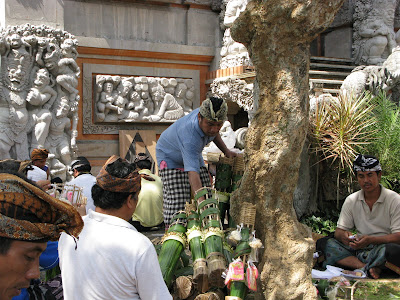 Preparations for the royal cremation in Ubud, Bali. The whole village had to help. The preparations lasted for weeks (pictures above and below).
Preparations for the royal cremation in Ubud, Bali. The whole village had to help. The preparations lasted for weeks (pictures above and below). Animal-shaped sarcophaguses are being built in the temples of Ubud.
Animal-shaped sarcophaguses are being built in the temples of Ubud. 
 Tjokorda Gede Agung Suyasa, who for three decades had served as the bendesa (chief) of Ubud, Bali passed away in March 2008. For four months his body had been placed in a pavilion at his family royal compound while waiting for cremation day. During daylight his body was exposed to the sun, this is at least what our Ubud taxi driver told us, as I asked him how the body was treated to avoid decay.
Tjokorda Gede Agung Suyasa, who for three decades had served as the bendesa (chief) of Ubud, Bali passed away in March 2008. For four months his body had been placed in a pavilion at his family royal compound while waiting for cremation day. During daylight his body was exposed to the sun, this is at least what our Ubud taxi driver told us, as I asked him how the body was treated to avoid decay.
BTW, the cremation ceremony changed considerably. Pierre Dubois, who lived in Bali from 1827 to 1831, tells us that so called belas would commit suicide to demonstrate their loyality to the person being cremated. A bela always had the right to choose the method of death, which means burning alive would only be one option besides others. (See Pierre Dubois, A Cremation, in: Adrian Vickers (ed.): Travelling to Bali: Four Hundert Years of Journeys. p.89- 101).
Labels: Bali, festivities, Indonesia Java, religion
 This fellow was probably forced to wake up too early in the morning. Imam's in Indonesia are not restricted in using their moshola loudspeakers at certain times. Often the public chanting starts well before morning prayers shortly after 4AM. Loudspeaker preaching usually comes after the prayers. If you have the pleasure of living next to such a moshola you need sweet dreams during normal working hours.
This fellow was probably forced to wake up too early in the morning. Imam's in Indonesia are not restricted in using their moshola loudspeakers at certain times. Often the public chanting starts well before morning prayers shortly after 4AM. Loudspeaker preaching usually comes after the prayers. If you have the pleasure of living next to such a moshola you need sweet dreams during normal working hours.



































